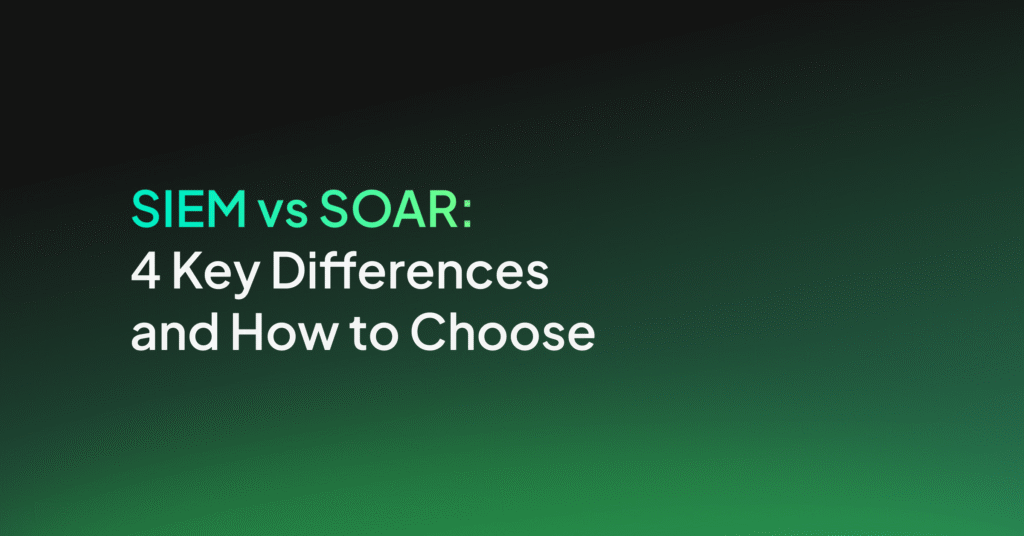SOC and SIEM: The Team and the Tool

What Is the Difference Between a SOC and a SIEM?
SOC is a team, while SIEM is a tool:
- The primary function of a SIEM system is to aggregate and analyze data to identify potential security incidents.
- A SOC team uses the data provided by the SIEM, among other tools, to monitor and respond to security incidents.
In other words, a SOC uses a SIEM system as a part of its arsenal. The SIEM system consolidates data and generates alerts, while the SOC team investigates these alerts, determines whether a security incident has occurred, and decides on the appropriate response.
Why Does a SOC Need a SIEM System?
SIEM is a foundational technology in most security operations centers. Let’s explore the primary challenges faced by SOC teams, which SIEM helps to solve.
Limited Visibility
One of the biggest hurdles in building a SOC is achieving full visibility into the organization’s IT environment. This includes understanding all devices connected to the network, the data they hold, and the potential vulnerabilities they might have. Without this insight, the SOC team can’t effectively monitor or defend the organization’s assets. SIEM addresses this by bringing together data from the entire IT environment into one interface.
White Noise
Another challenge is dealing with the sheer volume of data and alerts generated by the security tools. This is commonly referred to as “white noise.” Sorting through this noise to identify legitimate threats is a significant challenge. It requires sophisticated tools and skilled analysts to distinguish between routine activity and potential security incidents. SIEMs can help by normalizing security events, aggregating them, and helping to prioritize them.
False Positives and Alert Fatigue
Finally, false positives and alert fatigue are major obstacles. A false positive occurs when a security tool incorrectly identifies benign activity as malicious. Too many false positives can lead to alert fatigue, where analysts become desensitized to alerts due to their frequency. This can result in genuine threats being overlooked. Modern SIEM systems use big data analytics and machine learning algorithms to reduce false positives and identify security events that matter.
Primary Uses of SIEM in a SOC Team
Here are the primary ways SOC teams use SIEM to their advantage.
Log Aggregation
In a modern IT environment, components such as servers, applications, and network devices continuously generate logs. These logs contain valuable information regarding the activities and events occurring within the system. However, the sheer volume and diversity of these logs can make it difficult for security teams to manage and analyze them effectively.
SIEM systems address this challenge by offering log aggregation capabilities. They collect logs from various sources, normalize them into a consistent format, and store them in a central location. This aggregation makes it easier for SOC teams to manage and analyze the logs. They can quickly identify patterns, trends, and anomalies that may indicate a security threat.
Moreover, log aggregation improves the efficiency of forensic investigations. In the event of a security incident, SOC teams can easily access, search, and analyze the aggregated logs to understand what happened, when it happened, and who was involved. This ability to quickly trace back events is invaluable in mitigating the impact of security incidents and preventing future occurrences.
Adding Context to Security Events
Another significant advantage of SIEM systems is the increased context they provide. SIEM systems not only collect logs but also correlate them with other relevant information such as threat intelligence, user behavior, and network activity. This correlation provides a broader context that helps SOC teams to understand the full scope and implications of a security event.
For instance, a simple log entry indicating a failed login attempt may not seem alarming on its own. However, when correlated with other information such as multiple failed login attempts from the same IP address in a short period, or a known malicious IP address, this event becomes far more significant.
This increased context allows SOC teams to make more informed decisions. They can prioritize their response based on the severity and potential impact of a security event. Furthermore, the increased context also aids in accurately identifying false positives, saving valuable time and resources.
Prioritizing Alerts
Security teams have to deal with an overwhelming number of alerts, many of which turn out to be false positives. This high alert volume can lead to alert fatigue, where important alerts are missed or ignored due to the overwhelming number of alerts.
SIEM systems help combat this issue by using advanced analytics and correlation techniques to filter out irrelevant alerts and prioritize the most critical ones. They can identify patterns and relationships between different events, allowing them to group related alerts together. This capability reduces the number of alerts that the SOC team needs to investigate, thereby improving their efficiency and effectiveness.
By reducing the alert volume, SIEM systems also help to reduce the risk of alert fatigue. This ensures that SOC teams remain vigilant and responsive to true security threats.
Automated Threat Detection
With the increasing sophistication and frequency of cyber-attacks, manual threat detection methods are no longer sufficient. SOC teams need automated tools that can continuously monitor the system and automatically identify potential threats.
SIEM systems meet this need by offering automated threat detection capabilities. They use advanced analytics, machine learning, and behavioral analysis to continuously monitor IT systems and identify anomalies that may indicate a security threat. These anomalies are then flagged as alerts for further investigation by the SOC team.
This automated threat detection not only improves the speed and accuracy of threat detection but also frees up valuable time for the SOC team. They can focus on responding to confirmed threats and improving the organization’s overall security posture, rather than spending time on manual threat detection activities.
Snowbit MDR
Snowbit combines Coralogix’s advanced SIEM with expert-managed security services, creating a unique and cost-effective solution for comprehensive threat protection. Offering proactive, 24/7 monitoring of security events and posture, Snowbit acts as an extension of your security team to not only identify threats and incidents in real time but also resolve them within minutes. With transparent pricing and in-stream data optimization, Snowbit provides unparalleled protection without complexity and is trusted globally to secure cloud environments with speed and precision.




